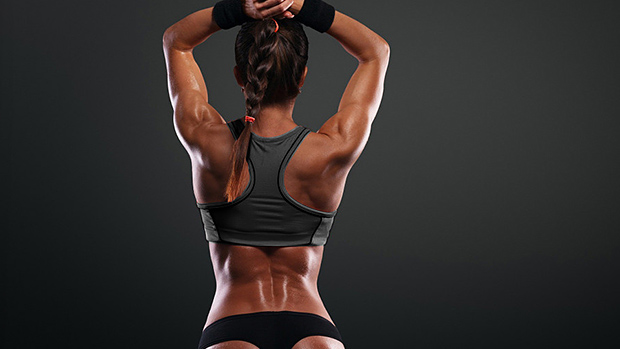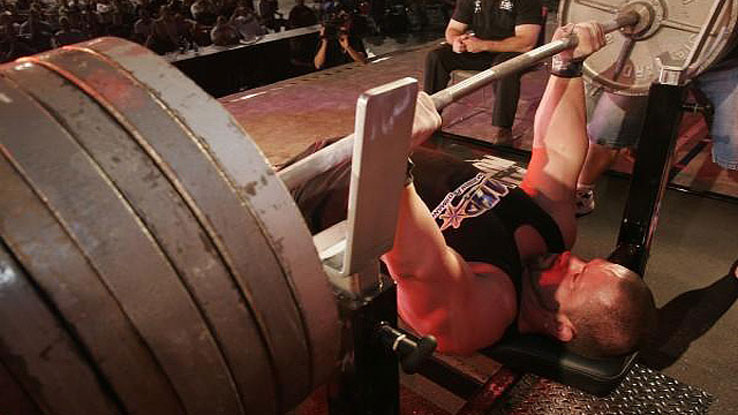Perform Better... Naked
Having a well-built midsection is sure to set you apart whenever the opportunity to take your shirt off arises, but there are a lot of other reasons to train your abs. For one thing, strong and balanced abs are (along with strong glutes) the best way to avoid lower back pain, something that plagues a majority of the sedentary population.
Strong abs are also important for athletic performance. Your trunk is the link between your upper and lower body. As such, all force developed must go through the trunk.
Simply put, without a strong midsection, optimal performance isn't possible. Imagine having to play football with a pillow for a trunk. Not gonna be pretty! Now imagine having a big rock for a torso. Now we're talking! A properly trained midsection will be more solid, have better force absorption, and be able to express more strength, power, and speed.
As you can see, training the abdominals goes way beyond simply looking good naked. But hey, most people simply want to look great, and there's nothing wrong with that. Just know that by getting that hard midsection you've been dreaming about you'll also get a lot more than stares going your way!
Now, I must add one thing: most people actually hate training abs! They like the results (once they're lean enough to see them) but the whole process of hard ab training simply doesn't appeal to that many people.
Let's face it, if you just completed a hellish lifting session that leaves you gasping for air and looking for the quickest way out of the gym, chances are you won't have the mental fortitude or motivation to hit abs intensely. Sure, you might guilt yourself into doing a few easy sets at the end of your workout, but nothing serious enough to give you real results.
There's also the time factor. Some lifters simply don't have a lot of time to spend in the gym. Adding 20-30 minutes of intense ab work at the end of a workout might not be practical.
The strategy I use with my clients is to have them perform one set of abdominal work after each set of every exercise in their regular weight training workout. This allows them to perform anywhere from 9 to 20 sets of abs without even noticing it!
It also doesn't significantly increase the length of the workout. Every time you change your strength exercise you also move on to another abdominal movement. For example, if you were to train chest and back using three movements per muscle group and an alternating structure, a workout including staggered ab training could look like this:
| Exercise | Sets | Reps | |
|---|---|---|---|
| A1 | Bench Press | 5 | 4-6 |
| After each set perform one set of incline Garhammer raise (described below), then rest 90 seconds before moving on to A2. | |||
| A2 | Weighted Pull-Up | 5 | 4-6 |
| After each set perform one set of cable crunches then rest 90 seconds before moving back to A1. | |||
| B1 | Incline Dumbbell Press Hammer Grip | 4 | 6-8 |
| After each set perform one set of Swiss ball crunches, then rest 75 seconds before moving on to B2. | |||
| B2 | Lat Pulldown | 4 | 6-8 |
| Lean back 45 degrees with a close parallel grip. After each set perform one set of double crunches, then rest 75 seconds before moving back to B1. | |||
| C1 | Decline Dumbbell Fly Pronated Grip | 3 | 8-10 |
| After each set perform one set of high-pulley woodchop, then rest 60 seconds before moving on to C2. | |||
| C2 | Seated Rope Row to the Neck | 3 | 8-10 |
| After each set perform one set of lateral trunk flexion, then rest 60 seconds before moving back to C1. | |||
Without knowing it you'll have performed 24 sets of ab work by the end of your workout!
With this particular option you have three different ab workouts. The exercises you use on each day are divided into functional units, meaning that on each separate day you'll use exercises that target one specific function of the abdominal muscles:
- Day 1: Trunk Flexion
- Day 2: Trunk Rotation
- Day 3: Trunk Stabilization and Lateral Flexion
Here are some exercise choices:
Exercise 1: Garhammer Raise

This is one of my favorite abdominal exercises. At first glance it looks like a leg raise, but it's actually only "half" of a leg raise. During a regular leg raise the first half of the movement involves mostly hip flexion, not trunk flexion. This means that the hip flexors (psoas, rectus femoris) do most of the work. Furthermore, since these are activated first they'll tend to overtake the second part of the movement too. Obviously this leads to very little actual abdominal activation.
The Garhammer raise bypasses that problem by starting the movement with the hips bent at 90 degrees. From that position you perform a lumbar flexion to bring the knees toward your chest. This is a short movement, but it's all abs!
The difficulty of the movement is increased by increasing the angle of the bench. You can go from the floor (as illustrated) to a low incline (15-30 degrees) to a moderate incline (30-45 degrees) to a steep incline (45-60 degrees) and finally to the hanging variation.
Reps should be in the 12-15 range. If you can get 15 in good form, increase the incline.
Exercise 2: Cable Crunch

The key to this exercise is to emphasize "rolling" the spine, not just flexing the trunk forward. To get a good idea of the proper trunk action, imagine that you're receiving a powerful punch in the stomach.
Remember, if you want visible abs you must have both a low body fat level and thick abdominal muscles. When your abs are thick, especially the rectus abdominis or "six pack," they stand out more because the contrast between the muscle bellies (the actual ''packs'') and the linea alba is more pronounced. To get strong and thick abs, you must use loaded abdominal work.
To thicken up your abs, sets of 8-10 reps should be used with any loaded movements.
Exercise 3: Serratus Crunch

This movement is great to build up both the rectus abdominis and serratus anterior. The serratus help stabilize the shoulder blades and give that thick, superhero-like ribcage look to your body.

The key point with the serratus crunch is to extend the arms straight up toward the ceiling, not up and forward. It's also important to reach up as high as humanly possible at the end of the repetition and to hold that top position for 1-2 seconds. Sets of 10 to 12 reps should be performed.
Other Exercises for Trunk Flexion Day
- Swiss Ball Crunch: Unloaded movement for maximum reps, or holding a dumbbell overhead for 10-12 reps.
- High Pulley Cable Crunch on Swiss Ball: Loaded movement for 8-10 reps.
- Low Pulley Serratus Crunch: Loaded movement for 10-12 reps.



Note: There isn't one exercise that's superior to all the others. The key is to find the best exercises for you. It's also nice to have several alternatives to spice up your workouts.
Exercise 1: High Pulley Woodchop

The woodchop is a great exercise for the obliques, but it's rarely done properly. Most people use their arms or lats too much in the movement, taking much of the stimulation away from the trunk.
You really should see the arms as ''hooks'' holding on to the rope, or as a continuation of the rope. In other words, the arms should be as passive as possible. Focus on executing the movement with the trunk, not your arms or upper body.
Sets of 12-15 reps should be performed on this movement. You can also perform it standing.
Exercise 2: The Cyclone

The cyclone is a cross between a side trunk flexion and a trunk rotation. Anchor your feet to the back extension bench and hold a dumbbell with both hands. Bend your trunk sideways toward the ground and rotate down at the same time. Finally, flex your trunk upward while simultaneously rotating it.
This movement can be stressful on the lower back, so if you have back problems be careful. For that same reason it's best to execute this movement slowly.
Perform 8-10 reps per side.
Exercise 3: Twisting Crunch on Swiss Ball

This is a pretty straightforward movement. Lying on a Swiss ball, perform a crunch while twisting your torso and trunk. Alternate sides on each rep. Since this is an unloaded movement perform a maximum of reps while maintaining proper form.
Other Exercises for Trunk Rotation Day
- Incline Russian Twist: Loaded or unloaded movement performed for 10-12 reps per side.
- Russian Twist on Floor: Loaded or unloaded movement performed for 10-12 reps per side.
- Full Contact Twist: Loaded movement performed for 8-10 reps per side.


Exercise 1: Forward Abdominal Roll
For this one you can use either an ab wheel or a barbell loaded with a pair of 10 pound plates. Start on your knees and roll yourself out, keeping your abs tight. Once you're parallel to the floor, bring yourself up, back to the starting position. For this exercise, perform as many reps as you can in good form.
Exercise 2: Three Position Bridge


This exercise consists of performing the three bridge positions – on your left side, on your right side, and plank – one after the other. The goal is to keep a neutral spine. Hold each position for 30 to 45 seconds (you might want to start at 15 seconds). Perform all three positions one after the other, without rest. Start with your weaker side, then your stronger side, and finish with the plank.
Exercise 3: Lateral Flexion on Back Extension Bench

This one is similar to the cyclone, with the difference being that you only perform a lateral flexion. At all times in the range of motion, the shoulders and hips should be aligned (meaning that both shoulders should stay in the same plane as the rest of the body; the torso should not rotate).
Perform 10-12 reps per side. If you can reach 12 reps you can start to hold a weight on your chest. Lateral flexion movements should be performed slowly to avoid lumbar stress.
Other Exercises for Trunk Stabilization and Lateral Flexion Day
- Dumbbell Side Bend: Loaded movement performed for 10-12 reps per side.
- Saxon Side Bend: Loaded movement performed for 10-12 reps per side.
- Reverse Cable Side Bend: Loaded movement performed for 10-12 reps per side.



While some people like to do ab work (they're normally the same ones who like to do hours of cardio wearing spandex), most hardcore lifters see it as a necessary evil that they'd rather avoid doing. Staggered ab training gives you the opportunity to bypass the boredom of abdominal work, allowing you to get better results simply because you'll be able to stick to the strategy!
Understand that the strategy I presented showed the option of doing one set of abs between every strength set of the workout. You don't have to do so. You can choose to perform less ab work than what I've shown. But regardless of what you decide to do, this strategy is sure to help you build those packs while keeping your training intensity and interest high!





